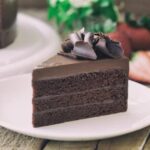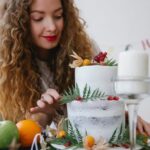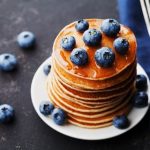Decorating a cake is an essential aspect of baking that can truly elevate the appearance and appeal of your sweet creations. Whether you’re a seasoned baker or just starting out, learning how to decorate a cake can open up a world of creativity and possibilities. In this article, we will explore the intricate art of cake decorating, with a special focus on utilizing videos as a helpful resource for mastering this skill.
For beginners, the idea of decorating a cake may seem daunting, but with the right tools and materials, anyone can create beautiful designs that are sure to impress. From piping bags and tips to fondant and edible decorations, having the proper equipment on hand is key to achieving professional-looking results.
In the following sections, we will delve into the step-by-step process of baking a cake, preparing various types of frosting, and uncovering valuable tips and tricks for decorating cakes like a pro.
Whether you’re looking to create intricate designs or simply add a personal touch to your baked goods, understanding different cake decorating techniques is crucial. With the help of piping bags and tips, you can achieve elaborate swirls, flowers, and patterns that will take your cakes to the next level.
Additionally, we’ll explore common mistakes to avoid when decorating cakes and showcase inspiring videos that demonstrate various creative ways to decorate your confections. Join us on this exciting journey as we delve into the art of cake decorating through informative visuals and expert tips.
Tools and Materials Needed for Cake Decorating
Decorating a cake is not only a delicious treat but also an art form that allows you to showcase your creativity and style. To create beautifully decorated cakes, you will need the right tools and materials to bring your vision to life. Here is a list of essential items you will need in your cake decorating arsenal:
- Offset spatula: This tool is essential for spreading frosting smoothly on cakes and creating clean lines.
- Piping bags and tips: These are used for intricate designs and adding details to your cakes.
- Turntable: A rotating turntable makes it easier to frost and decorate cakes evenly from all angles.
- Bench scraper: This tool helps achieve smooth sides and sharp edges on frosted cakes.
- Fondant smoother: For those who work with fondant, a fondant smoother is crucial for achieving a flawless finish on cakes.
In addition to these basic tools, you will also need various materials such as different types of frosting, food coloring, edible decorations, and any specific accessories required for the specific design you want to create. With the right tools and materials at hand, you’ll be well-equipped to begin your cake decorating journey.
If you are new to cake decorating or looking to improve your skills, watching a “how to decorate a cake video” can be incredibly helpful. There are countless online tutorials available that demonstrate various techniques and styles in cake decorating.
These videos can provide step-by-step instructions, tips, and inspiration to help you elevate your cake decorating skills. Whether you’re interested in mastering buttercream flowers or perfecting intricate piping designs, watching videos can give you the guidance you need to create stunning cakes.
Step-by-Step Guide to Baking a Cake
Baking a delicious cake from scratch is a rewarding experience that allows you to customize flavors and textures to your liking. Whether you are a novice baker or have some experience in the kitchen, following a step-by-step guide can help ensure success in creating a delectable treat for any occasion.
Gather Your Ingredients
Before starting the baking process, gather all necessary ingredients and tools. The basic components for a simple cake recipe include flour, sugar, eggs, butter, baking powder, milk, and vanilla extract. Depending on the type of cake you want to make, you may also need additional flavorings such as cocoa powder or lemon zest. Make sure all ingredients are at room temperature to ensure proper mixing and baking.
Mixing and Baking the Cake
Start by preheating your oven according to the recipe instructions. In a mixing bowl, cream together the butter and sugar until light and fluffy. Add in the eggs one at a time, mixing well after each addition.
Gradually incorporate the dry ingredients alternately with the wet ingredients until a smooth batter forms. Pour the batter into prepared cake pans and bake according to the recommended time and temperature. To check for doneness, insert a toothpick into the center of the cake – if it comes out clean, your cake is ready.
Cooling and Frosting
Once baked, allow the cakes to cool in their pans for about 10 minutes before transferring them to a wire rack to cool completely. It’s crucial to let them cool before frosting to prevent melting or sliding off. While waiting for your cakes to cool down, you can start preparing your frosting or icing based on your desired flavor and consistency.
Once cooled down completely, frost your cakes using your preferred decorating technique – whether it’s spreading on with an offset spatula or piping it on using decorative tips for intricate designs. Remember that practice makes perfect when it comes to decorating cakes, so don’t be afraid to get creative.
How to Prepare Different Types of Frosting for Cake Decorating
Decorating a cake is an essential part of the baking process, as it adds not only visual appeal but also enhances the overall taste and experience of enjoying a slice. One crucial aspect of cake decoration is choosing the right frosting or icing for your creation. Whether you prefer a smooth and creamy buttercream or a glossy and shiny ganache, selecting the perfect type of frosting can make all the difference in the final outcome of your cake.
To begin preparing different types of frosting for cake decorating, it’s important to gather the necessary ingredients and tools. For a basic buttercream frosting, you will need butter, powdered sugar, milk or cream, vanilla extract, and salt. If you opt for a chocolate ganache, be sure to have high-quality chocolate and heavy cream on hand. Additionally, consider any flavorings or colors you may want to incorporate into your frosting to match the theme or occasion of your cake.
Once you have all your ingredients ready, it’s time to start preparing your chosen frosting. Depending on the type of frosting you are making, the techniques may differ, but the key is to achieve a smooth and spreadable consistency that can hold its shape when piped onto the cake.
To learn more about specific recipes and methods for making different frostings for cake decorating, check out online tutorials and resources such as “how to decorate a cake video” guides that offer step-by-step instructions from experienced bakers. By following along with visual demonstrations, you can pick up valuable tips and tricks to perfect your cake decorating skills.
| Types of Frosting | Main Ingredients |
|---|---|
| Buttercream | Butter, powdered sugar, milk/cream |
| Ganache | Chocolate, heavy cream |
Tips and Tricks for Decorating Cakes Like a Pro
Decorating cakes like a pro requires practice, patience, and the right techniques. Here are some tips and tricks to help you elevate your cake decorating skills:
- Start with a smooth and level cake surface by using a cake leveler or a serrated knife to even out the top of the cake layers.
- Crumb coat your cake with a thin layer of frosting to seal in any crumbs before applying the final layer of frosting. This will give your cake a polished look.
- Invest in quality tools such as offset spatulas, bench scrapers, and piping bags to help you achieve clean lines and intricate designs on your cakes.
Creating beautiful cakes also involves paying attention to details and adding personal touches that make your creations stand out. Here are some additional tips for decorating cakes like a pro:
- Experiment with different textures and finishes by using various piping tips, stencils, or edible decorations like sprinkles, edible glitter, or fresh flowers.
- Practice precision when piping designs onto your cakes by holding the piping bag at the right angle and applying consistent pressure for smooth lines.
- Don’t be afraid to mix and match colors or try out new techniques. The more you practice and experiment, the more confident you’ll become in creating unique cake designs.
By following these tips and tricks, along with watching instructional videos on how to decorate a cake, you’ll be well on your way to mastering the art of cake decorating like a pro. Remember that practice makes perfect, so don’t get discouraged if your first attempts aren’t flawless – every mistake is an opportunity to learn and improve your skills as a cake decorator.
How to Use Piping Bags and Tips for Intricate Designs
Piping bags are essential tools for creating intricate designs and decorations on cakes. These bags are typically made of plastic or cloth material and are used to pipe frosting or icing onto cakes in various designs. Along with piping bags, different types of tips are also needed to achieve specific patterns and textures on the cake.
Choosing the Right Piping Tips
When it comes to decorating cakes with piping bags, selecting the right piping tip is crucial. There are a wide variety of tips available, each producing a different design when used. For example, round tips are perfect for writing or outlining shapes, while star tips can create beautiful rosettes or borders. It’s important to experiment with different tips to see which ones work best for the design you want to achieve.
Filling and Handling Piping Bags
Before using a piping bag, make sure it is properly filled with frosting or icing. To fill a piping bag without making a mess, place the bag in a tall glass or cup and fold down the top edges over the rim. This creates a sturdy opening for spooning in your frosting.
Once filled, twist the top of the bag and gently squeeze from the top down towards the tip to release air bubbles. When handling a piping bag, hold it securely from the top end while applying pressure with your dominant hand at the base to guide the frosting flow.
Common Mistakes to Avoid When Decorating Cakes
Decorating cakes can be a fun and creative process, but it also comes with its own set of challenges. Avoiding common mistakes is essential to ensure that your final product looks as beautiful as you envisioned. One of the most common mistakes beginners make is not allowing their cake layers to cool completely before starting the decorating process. Frosting a warm cake can cause it to crumble, leading to a messy final presentation.
Another mistake to avoid is using the wrong type of frosting for your cake. Different frostings have different consistencies and properties, so it’s important to choose one that complements the texture of your cake. Additionally, overmixing your frosting can lead to air bubbles, which will affect the smoothness of your decorations. It’s crucial to mix your frosting just until it reaches the right consistency.
When it comes to intricate designs and piping work, one common mistake is using piping bags that are either too full or too empty. A piping bag that is too full can be difficult to control and may result in uneven decoration.
On the other hand, a piping bag that is too empty can create inconsistent pressure, leading to irregular lines or shapes on your cake. Finding the right balance in filling your piping bag is key to achieving professional-looking designs.
| Common Mistakes in Cake Decorating | How to Avoid Them |
|---|---|
| Not allowing cake layers to cool completely before decorating | Ensure cakes are fully cooled before applying frosting |
| Using the wrong type of frosting for the cake | Choose a frosting that complements the texture of the cake |
| Overmixing frosting leading to air bubbles | Mix frosting just until it reaches desired consistency |
Showcase of Different Cake Decorating Techniques Through Videos
Cake decorating videos are a fantastic resource for both beginners and experienced bakers looking to enhance their skills. These videos provide visual demonstrations of various techniques, styles, and designs, making it easier to grasp the process and replicate it at home. Whether you’re interested in learning how to create intricate floral designs using buttercream or mastering the art of fondant sculpting, there is a video out there to guide you through the process step by step.
One of the best aspects of cake decorating videos is that they allow you to follow along at your own pace, pausing and rewinding as needed to fully understand each step. This can be especially helpful when attempting more advanced techniques such as sugar flower crafting or airbrushing. Additionally, watching different decorators in action can provide inspiration for your own unique creations and help you develop your personal style.
For those just starting out in cake decorating, beginner-friendly tutorials can be found on popular platforms like YouTube and baking websites. These videos typically cover foundational skills such as smoothing icing, piping borders, and basic fondant techniques.
As you gain more experience and confidence, you can explore more advanced tutorials that delve into complex designs like tiered cakes or gravity-defying structures. By regularly watching and practicing with cake decorating videos, you’ll soon be able to create show-stopping cakes that look as professional as those from a bakery.
Conclusion
In conclusion, mastering the art of cake decorating is not only a fun and rewarding skill to learn but also an opportunity to unleash your creativity and showcase your personality through beautifully decorated cakes. By following the step-by-step guide provided in this article and familiarizing yourself with the necessary tools and materials, you can elevate your baking game and create stunning desserts that are sure to impress your friends and family.
Watching a “how to decorate a cake video” can be a great way to further enhance your skills and learn new techniques from experienced bakers in the comfort of your own home. These videos offer visual demonstrations that can help clarify any uncertainties you may have about certain decorating methods, allowing you to gain confidence in your abilities and experiment with different styles.
As you continue on your cake decorating journey, remember that practice makes perfect. Don’t be discouraged by mistakes or imperfections along the way; instead, use them as learning experiences to improve and refine your skills.
Whether you’re creating intricate designs with piping bags or experimenting with different types of frosting, enjoy the process and savor the joy of sharing your beautifully decorated cakes with others. Keep honing your craft, exploring new techniques, and most importantly, have fun expressing yourself through the art of cake decorating.
Frequently Asked Questions
How to Decorate Cake in a Simple Way?
Decorating a cake in a simple way can be achieved by using basic techniques like spreading frosting smoothly over the cake, piping borders or designs with different tips, and adding sprinkles or edible decorations. You can also use fresh fruits or flowers for a natural touch.
How Can I Make My Cake Look Beautiful?
Making your cake look beautiful involves paying attention to details such as choosing a color scheme that complements each other, using different textures like buttercream or fondant, adding layers for depth, and incorporating intricate designs or patterns. Adding a personalized message or monogram can also enhance the overall look.
What Do You Put a Cake on to Decorate It?
When decorating a cake, it is essential to place it on a sturdy surface like a rotating cake stand or turntable to make it easier to access all sides while decorating. A cardboard cake round or cake board can provide support and make it easy to transport the finished cake.
Using parchment paper strips beneath the edges of the cake can help keep your serving platter clean while decorating.

Welcome to my blog about home and family. This blog is a place where I will share my thoughts, ideas, and experiences related to these important topics. I am a stay-at-home mom with two young children. I hope you enjoy reading it! and may find some helpful tips and ideas that will make your home and family life even better!





